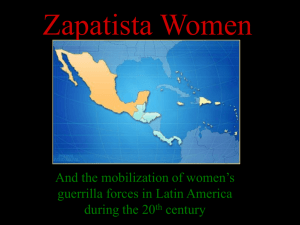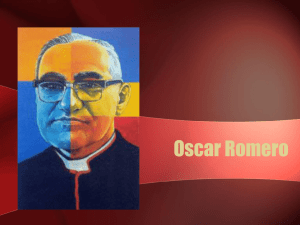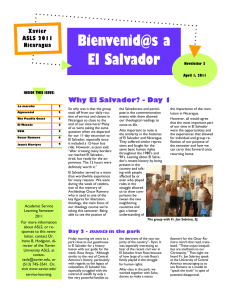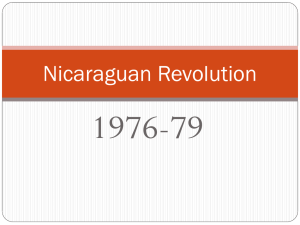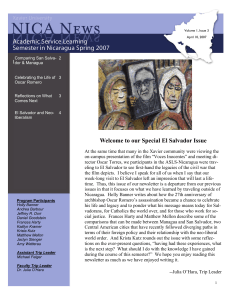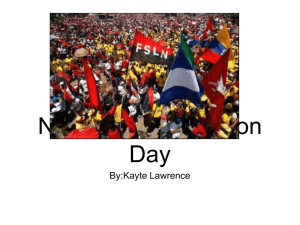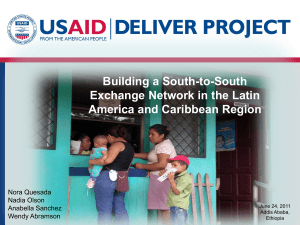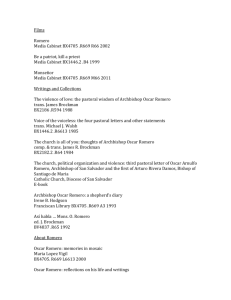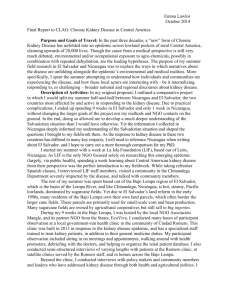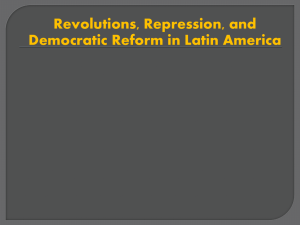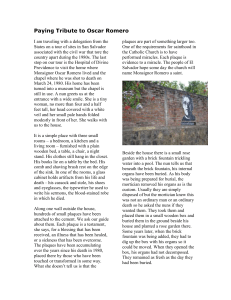How did the late cold war threaten the stability of central american
advertisement
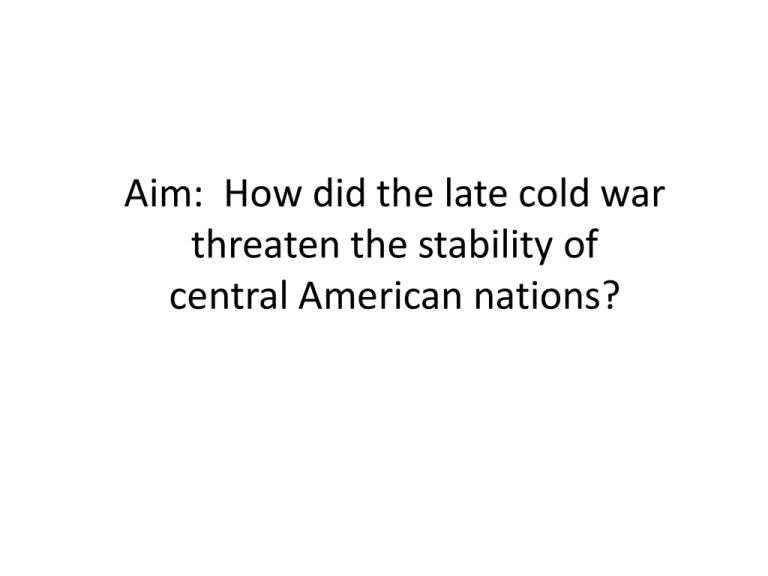
Aim: How did the late cold war threaten the stability of central American nations? How does this sentiment compare with the role of the Church in the Dirty War in Argentina? • In less than three years, more than fifty priests have been attacked, threatened, calumniated. Six are already martyrs—they were murdered. Some have been tortured and others expelled [from the country]. Nuns have also been persecuted. The archdiocesan radio station and educational institutions that are Catholic or of a Christian inspiration have been attacked, threatened, intimidated, even bombed. Several parish communities have been raided. If all this has happened to persons who are the most evident representatives of the Church, you can guess what has happened to ordinary Christians, to the campesinos, catechists, lay ministers, and to the ecclesial base communities. There have been threats, arrests, tortures, murders, numbering in the hundreds and thousands.... • But it is important to note why [the Church] has been persecuted. Not any and every priest has been persecuted, not any and every institution has been attacked. That part of the church has been attacked and persecuted that put itself on the side of the people and went to the people's defense. Here again we find the same key to understanding the persecution of the church: the poor. • —Óscar Romero, Speech at the Université catholique de Louvain, Belgium, Feb. 2, 1980. Central America as a battleground in the Cold War • Despite the rise of rightwing military junta’s in Brazil, Chile, and Argentina, left-wing revolutionary movements persisted elsewhere. • In the 1980s, the main battleground between leftist rebels and military forces backed by the US was Central America. Secretary of State Alexander Haig, Mar 19, 1981 • What we are watching is a four-phased [Soviet] operation of which phase one has already been completed — the seizure of Nicaragua, next is El Salvador, to be followed by Honduras and Guatemala. It's clear and explicit. I wouldn't call it necessarily a domino theory. I would call it a priority target list — a hit list, if you will — for the ultimate takeover of Central America. Nicaragua: From the Somozas to the Sandinistas • The US had intervened in Nicaraguan domestic affairs in the early 20th century, with US marines stationed there for long periods of time. • After the leader of the USsupported National Guard, Anastasio Somoza, seized control of the government in 1937, his family remained in power for 43 years and ruled the country as brutal dictators. Anastasio Somoza Nicaragua: From the Somozas to the Sandinistas • Opposition to the Somoza regime arose from Marxist guerrilla forces known as the Sandinista National Liberation Front, named after revolutionary leader Augusto Sandino. • By 1979, they were in virtual control of the country and the Somoza regime was overthrown. • Inheriting a poverty-stricken nation, the Sandinistas organized a provisional government aligned with the USSR. Nicaragua: From the Somozas to the Sandinistas • From the United States, the Reagan and Bush administrations financed the Contra rebels in a guerrilla war against the Sandinista government. • The Contra War and an American embargo damaged the Nicaraguan economy and undermined support for the Sandinistas. • In 1990, the Sandinistas agreed to free elections, and lost. However, they remain the strongest party in Nicaragua. Back in Power • In 1996, the former leader of the Sandinista National Liberation Front, Daniel Ortega, returned to the presidency of Nicaragua. Conflict in El Salvador • Tensions between the elites who controlled 95% of the wealth in El Salvador intensified at the start of the 20th century • In 1932, Agustin Farabundo Marti formed the Central American Socialist Party and led peasants and indigenous people against the government. • In response, the government supported military death squads which killed anyone who even looked Indian or may have been supporting the uprising. • In a killing known as La Matanza (the Massacre, 1932) left more than 30,000 people (mostly peasants) dead. Marti was eventually arrested and put to death. Mass Grave – Victims of La Montanza Memorial to the Victims in El Salvador The struggle continued through the 1970s • Both sides continued to fight back and forth in an endless string of assassinations and coups. • As the presence of guerillas existed, the military reinstated the death squads in order to combat the rebel forces. • In 1979, yet another military junta overthrew the government. • When the Junta failed to improve living standards in the country, discontent with the government provoked the five main guerrilla groups in the country to unite in the Farabundo Marti National Liberation Front (FMLN). Archbishop Oscar Romero Archbishop Oscar Romero's Letter to President Carter Archbishop Oscar Romero sent this letter to President Carter on Feb. 17, 1980. 1. Describe the tone of this letter. 2. What is the intended audience of this open letter to the President? 3. In your opinion, what were Romero’s primary goals in writing this piece? Underline/highlight the passages that suggest his motives. Civil War (1980-1992) • In 1980, El Salvador's civil war officially began. • The government-supported military targeted anyone they suspected of supporting social and economic reform. • Often the victims were unionists, clergy, independent farmers and university officials, anyone who could gain the support of the masses of peasant farmers. • Over the ensuing twelve years, thousands of victims perished. Some of the most notable were Archbishop Oscar Romero (shot to death 1980), four US church workers (raped and murdered 1980) and six Jesuit priests, their housekeeper and her daughter (shot to death at home 1989). Murdered US Church Workers The objective of death-squad-terror seemed not only to eliminate opponents, but also, through torture and the gruesome disfigurement of bodies, to terrorize the population. Civil War cont’d • The military death squads wiped-out entire villages believed to be assisting the guerrilla efforts. This effort was known as “draining the sea” or eliminating all possible support for the rebels from the countryside. • In 1981, the military killed over 1,000 people in the village of El Mozote. The first reports of the attacks were denied by both El Salvador and the United States, but after the mass graves were uncovered, it was hard to deny what had taken place. Memorial to the El Mozote Massacre, Dec. 11th, 1980 Civil War cont’d • The war persisted despite efforts from both sides to bring an end to the fighting. • The Salvadorian government was able to continue its efforts with help from the US, which had begun supporting the government with financial and military aid/training through the famous School of the America’s in Panama as soon as the war started. • Although the US temporarily suspended funds after the rape and murder of the church women in 1980, apparent growing socialist support in Nicaragua encouraged President Reagan to reactivate support for El Salvador. Civil War cont’d • Military and monetary aid supporting the Salvadoran government from the US continued until 1990. During the height of the war, aid averaged 1.5 million dollars per day. • The US finally ceased support only in 1990 after the United Nations became involved, and reports of human rights violations were confirmed. • Eventually, the military aid from the US became reconstruction aid. • Currently, the US sends about 30-35 million dollars annually to El Salvador, one of the poorest countries in Central America. President Obama visits Romero’s Tomb, 23 March, 2011.
